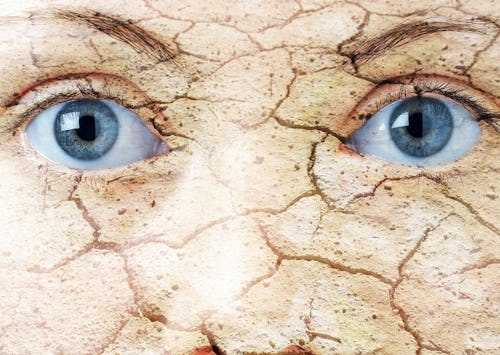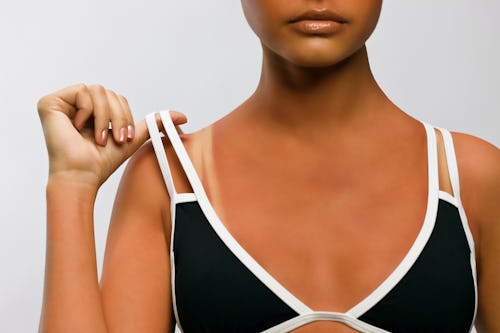
In the United States, wildfires have scorched the West, while hurricanes have flooded the Southeast. This June was the hottest one on record for the continental U.S., and July was the hottest month recorded on Earth. As long as climate change persists, we can expect these extreme weather events to happen with even more frequency and intensity.
Besides mitigating climate change through reducing our emissions, we also need to learn to adapt to it. While that could look like moving to higher ground amid sea level rises or planting drought-resistant crops, it might also require changes to more mundane aspects of our day-to-day that we often take for granted — like our skincare routine. Mic spoke to experts about how the effects of climate change, from hotter temperatures to wildfire smoke, could mess with your skin, and what steps you can take to protect it.
Extreme heat
Let’s start with how hotter temperatures can do a number on your skin. “Hot weather, during summer or when residing in warmer or humid climates, can lead to skin dehydration as we sweat to cool ourselves,” says Samy Hamada, head of research and development and compliance at skin, hair, and body care brand Aesop.
According to UW Health dermatologist Apple Bodemer, your skin cells normally form a brick-and-mortar barrier. But when your skin is too dry, the “mortar” starts to dissolve, allowing toxins, allergens, irritants, pathogens, and UV radiation to penetrate not only the topmost layer of the skin — the epidermis — but also the layer beneath it — the dermis.
“That can set you up for a whole host of problems,” she says, like itchiness, which is most commonly caused by dry skin. Dryness can also throw off the skin’s pH, disrupting its delicate bacterial ecosystem, or microbiome, which helps strengthen the skin barrier. “Then we see more problems with the overgrowth of pathogenic bacteria,” she explains, which can start a vicious cycle of worsening skin barrier function and infection.
Hotter weather also triggers increased sweat production, which Bodemer says can aggravate eczema symptoms in those who have the skin condition. “Eczema is complex, and it always starts with repairing the skin barrier,” she tells Mic.
Moisturizers can help with both the dryness and eczema that hot weather can exacerbate, says Bodemer, who’s “a big fan of the food grade oils as moisturizers.” Most have antimicrobial properties, which means they maintain low levels of bacteria and yeast on the skin. They typically don’t have preservatives, additives, artificial colors, or scents, either, making it easier to identify the culprit behind any allergic reaction you happen to experience (versus with a moisturizer that contains a laundry list of hard-to-pronounce ingredients).
“Avocado oil is one of my favorites for people who have really dry skin, and almond oil is kind of a tested and true oil that’s used a lot in massage therapy,” Bodemer says. Chances are, you won’t have a problem with mid-weight oils — that is, most oils — if you’re not prone to breakouts. But if you do have blemish-prone skin, she recommends apricot kernel oil or jojoba oil. If you struggle with dry skin or rosacea (the dry, flaky, red variety, without as much blemishing), opt for something heavier like coconut oil.
“I always test it out,” Bodemer says. “If it’s too heavy for you, and you notice that you’re getting more breakouts, then choose a lighter weight oil.” And if an oil doesn’t work out, you can always cook with it.
Bodemer recommends coconut oil and sunflower seed oil in particular if you have eczema. But chances are, you may need “something that is a little stronger from an anti-inflammatory standpoint,” she says. She suggests hydrating the skin first, then looking into botanical and prescription topicals if necessary.

Drinking water is also key to preserving your skin barrier as temperatures rise. That’s because food grade oils and other moisturizers work not by adding moisture to the skin, Bodemer says, but by drawing it from the tiny blood vessels in the skin and preventing evaporation. If you’re dehydrated, though, you won’t have enough water to draw from those blood vessels, she explains.
According to Hamada, your skin could also produce more oil in response to dryness. “This combination of oil and sweat can lead to congestion, reactivity and aggravation,” he says, which may require more thorough cleansing with astringent toners.
Extreme cold
Climate change can bring not only extreme heat, but also extreme cold. A recent study, for instance, correlated the cold wave that slammed Texas in February to the polar vortex "stretching out," a phenomenon that may have become more frequent with climate change.
What does that mean for your skin? If you live in regions that normally aren’t that cold in the winter, you may find yourself heading inside and turning on the heat, Bodemer says. That, in turn, can create a stark temperature differential between the indoors and outdoors that can cause the blood vessels to dilate more, resulting in not only redness but loss of moisture. Again, applying food grade oils and drinking enough water can help protect your skin from the effects of colder winters, which can resemble those of hotter summers.
Hamada agrees that moisturizing is imperative in colder weather. “We recommend cleansing with more gentle formulations, layering hydration with skin-supportive balancing toners, and blending oils with a preferred moisturizer for additional nourishment,” he says.
Wildfires
Climate change wreaks havoc on more than weather patterns: It also boosts the risk of polluting wildfires. The smoke, dust, and other particulates they churn out can contribute to increased production of molecules called reactive oxygen species, which can compromise the skin barrier, Hamada says.
Particulates and particles can aggravate the skin, he adds, resulting in “hyperpigmentation, reactivity, and loss of skin suppleness and resilience.” Products that strengthen the skin with antioxidants, prevent airborne particulates from landing with a non-occlusive, flexible film, and offer sustained hydration can combat these stressors.
Cleansing is especially important in areas exposed to wildfire smoke. Bodemer agrees that certain pollutants can disrupt the skin barrier and even change the pH of the skin, although she notes “these are all more theoretical,” since we don’t have many good studies on the specific effects of ash and other wildfire pollutants. But if they do get into your pores, and your skin is blemish-prone, they could worsen acne.
To keep breakouts at bay during wildfire season, Bodemer suggests cleaning skin with warm water and a gentle cleanser twice a day — “gentle” being the operative word. Avoid harsh products that can damage the skin barrier, like scrubs or the antibacterial soap you use to wash your hands (unless you have a skin condition that warrants it). Finally, it bears repeating: Moisturize, moisturize, moisturize. This will keep the skin barrier strong and healthy, barricading it from the toxins, irritants, and allergens wildfires can release.
As unpredictable as the effects of climate change might be, it’s safe to say that “in general, people — and therefore their skin — will have to adapt to larger fluctuations of environmental conditions, whether hotter or cooler or changing much faster or more abruptly,” Hamada says. Protecting our skin from these ravages, though not impossible, may require more mindfulness than we're used to. “We will need to listen more closely to our skin, take careful note of what its condition is telling us, in order to help it to help us.”







